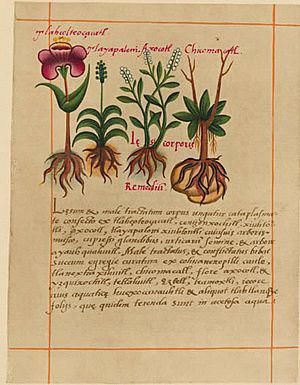Libellus de Medicinalibus Indorum Herbis facts for kids
The Libellus de Medicinalibus Indorum Herbis is a special Aztec book. Its name means "Little Book of the Medicinal Herbs of the Indians" in Latin. It describes many plants and how the Aztecs used them as medicine.
This book was translated into Latin by Juan Badiano in 1552. The original was written in the Nahuatl language by Martín de la Cruz. Sadly, the original Nahuatl version is now lost. The Libellus is also known by other names. These include the Badianus Manuscript and the Codex de la Cruz-Badiano.
The Badianus Manuscript was the first illustrated science book from the Americas. It showed Nahua medicine and plants. This makes it a very important text in the history of botany (study of plants) and the history of medicine.
Contents
The Book's Journey Through History
In 1552, a friar named Jacobo de Grado asked for this herbal book to be made. It was created for Don Francisco de Mendoza, whose father was the viceroy (a ruler representing the king) of New Spain. Mendoza sent the Latin book to Spain.
The book stayed in the royal library for a long time. Later, it was owned by a pharmacist to King Philip IV. Then, it went to an Italian Cardinal named Francesco Barberini. The book stayed in the Barberini family's library until 1902. At that time, their library became part of the Vatican Library.
Finally, in 1990, Pope John Paul II returned the Libellus to Mexico. Today, you can find it in the library of the National Institute of Anthropology and History in Mexico City.
Copies and Studies of the Manuscript
A copy of the Libellus was made in the 1600s. This copy is now part of the Royal Library, Windsor in England. Many printed versions of the manuscript have been made over the years.
One of the first printed versions was by William E. Gates in 1939. He published the original Latin text and his English translation. Later, Emily Walcott Emmart also published a full-color copy with her own English translation.
Scholars have studied the Libellus to learn about old medicine and plants. They look at how the Aztecs used plants for healing. The book shows that the Nahuas had a very advanced way of classifying plants.
The Libellus lists the Nahuatl names of plants. It also includes pictures and explains how each plant was used. Unlike some other old texts, this book focuses only on the medical uses of plants. It doesn't talk much about magical healing. For example, it lists plants used "Against stupidity of the mind" or "Medicine to take away foul and fetid breath."
Possible Link to the Voynich Manuscript
In 2014, some researchers suggested a connection between the Libellus and the Voynich Manuscript. The Voynich Manuscript is a mysterious book with unknown writing and strange plant drawings. Arthur Tucker and Rexford Talbert thought some plant pictures in both books looked similar.
They believed this might mean the Voynich Manuscript came from the Americas. However, other experts who study the Voynich Manuscript disagree. They think the similarities are just a coincidence. They say that any large group of made-up plant drawings might look a bit like real plants.
Translations of the Libellus
| Year | Language | Title | Translator | Publisher |
|---|---|---|---|---|
| 1939 | English | The De la Cruz-Badiano Aztec Herbal of 1552 | William Gates | The Maya Society |
| 1940 | English | The Badianus Manuscript (Codex Barberini Latin 241): An Aztec Herbal of 1552 | Emily Walcott Emmart | The Johns Hopkins Press |
| 1952 | Spanish | Libellus de Medicinalibus Indorum Herbis: El manuscrito pictórico mexicano-latino de Martín de la Cruz y Juan Badiano de 1552 | Francisco Guerra | Editorial Vargas Rea y El Diario Español |
| 1964, 1991 | Spanish | Libellus de medicinalibus indorum herbis: Manuscrito Azteca de 1552: versión Española con estudios y comentarios por diversos autores (ISBN: 968-16-3607-4) | Instituto Mexicano del Seguro Social | |
| 2000 | English | An Aztec Herbal: The Classic Codex of 1552 (ISBN: 0-486-41130-3) | William Gates | Dover (republication of 1939 edition) |
See also
 In Spanish: Códice De la Cruz-Badiano para niños
In Spanish: Códice De la Cruz-Badiano para niños
- Aztec entheogenic complex


